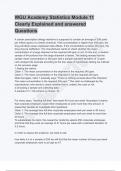Exam (elaborations)
WGU Academy Statistics Module 11 Clearly Explained and answered Questions
- Course
- Institution
WGU Academy Statistics Module 11 Clearly Explained and answered Questions A certain prescription allergy medicine is supposed to contain an average of 245 parts per million (ppm) of a certain chemical. If the concentration is higher than 245 ppm, the drug will likely cause unpleasant side effects....
[Show more]



